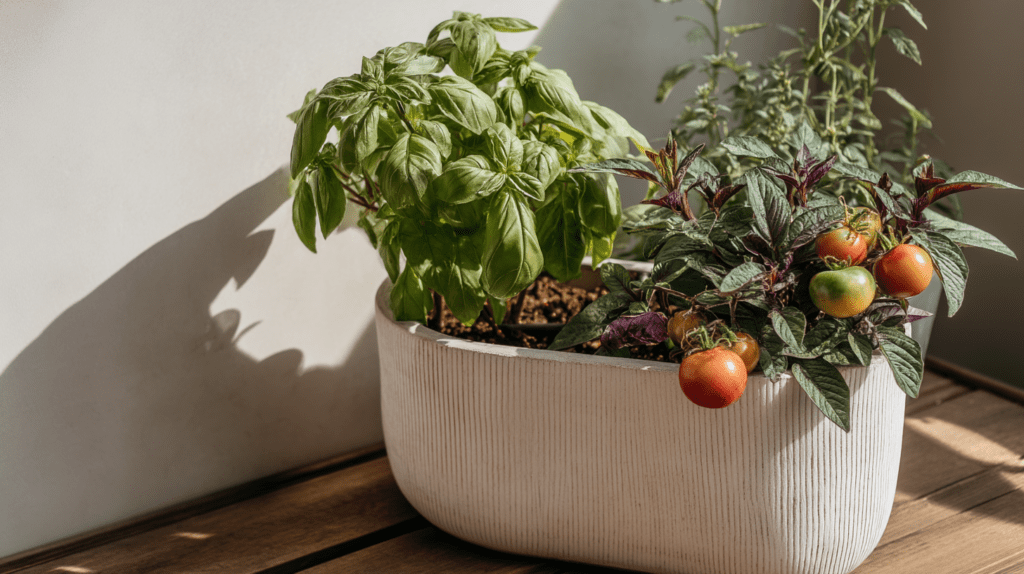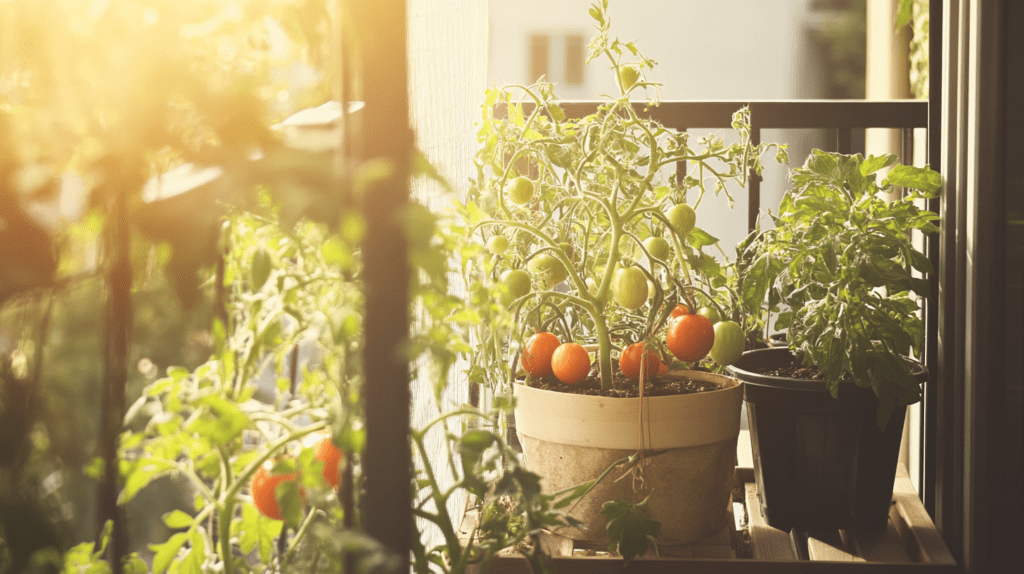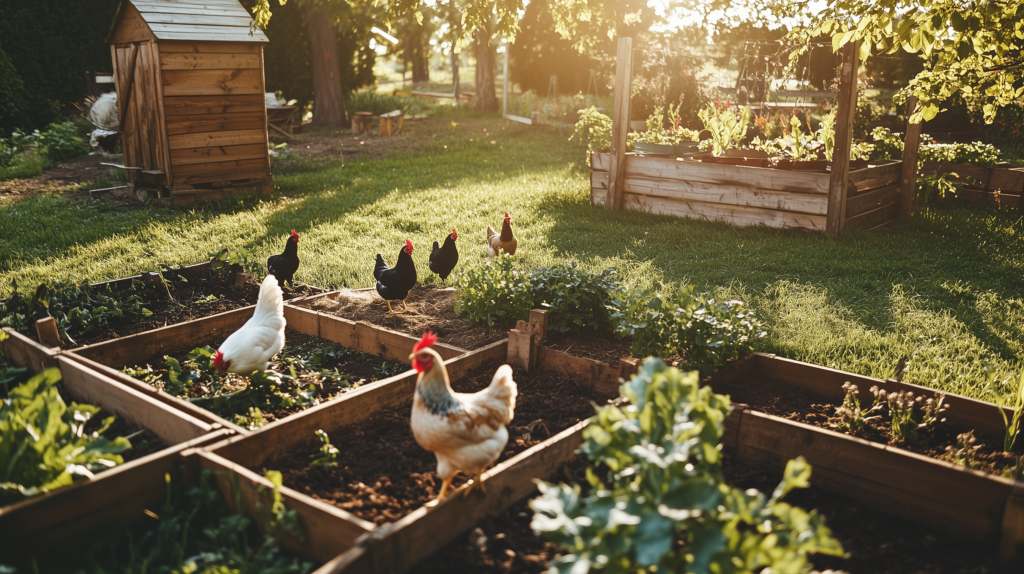This post may contain affiliate links, including those from Amazon Associates. If you make a purchase through these links, I may earn a commission at no additional cost to you. Learn more about our affiliate policy.
If you’re wondering which vegetables and herbs to plant together in your container garden, you’re in the right place.
Companion planting, pairing plants that help each other grow, can make your small-space garden thrive.
It’s all about choosing plants that team up to repel pests, improve soil, or boost flavor, especially in the tight quarters of pots.
Below, I’ve laid out the best pairings for popular container-friendly plants, with a clear chart and simple how-to tips to get you started. Let’s dig in!

Why Pair Plants in Containers?
In containers, space, nutrients, and sunlight are limited, so picking the right plant partners is key.
Good companions can deter bugs, enrich the soil, or even make your veggies taste better, all without extra effort. I’ve seen my own pots flourish with the right pairings, and I want that for you too.
Companion Planting: What Grows Together
These practical pairings are ideal for small-space gardeners and help boost growth, reduce pests, and make efficient use of space.
Tomatoes
Best companions: Basil, Parsley, Carrots, Onions
Why they work: Basil and parsley repel aphids. Carrots loosen the soil for better root growth. Onions deter insect pests.
Peppers
Best companions: Basil, Onions, Spinach
Why they work: Basil repels flies and mosquitoes. Onions keep common pests away. Spinach shades the soil and retains moisture.
Lettuce
Best companions: Radishes, Carrots, Strawberries
Why they work: Radishes and carrots break up soil to help lettuce roots thrive. Strawberries act as mulch and help with moisture retention.
Spinach
Best companions: Radishes, Carrots, Strawberries
Why they work: Same as lettuce—these companions improve soil and moisture levels.
Beans
Best companions: Corn, Cucumbers, Potatoes
Why they work: Corn provides vertical support. Beans add nitrogen to feed nearby plants. Potatoes help improve soil structure.
Basil
Best companions: Tomatoes, Peppers, Oregano
Why they work: Boosts flavor in tomatoes and peppers. Helps repel pests like hornworms.
Parsley
Best companions: Tomatoes, Asparagus, Roses
Why they work: Attracts beneficial insects like ladybugs. Supports overall growth of tomatoes.
Cilantro
Best companions: Spinach, Lettuce, Dill
Why they work: Deters aphids and attracts pollinators to the garden.
Thyme
Best companions: Cabbage, Eggplant, Strawberries
Why they work: Repels cabbage worms. Enhances flavor in eggplants.
Rosemary
Best companions: Beans, Carrots, Sage
Why they work: Keeps bean beetles away. Encourages strong carrot growth.
Mint
Best companions: Peas, Cabbage, Tomatoes
Why they work: Repels ants, fleas, and other pests.
Quick note: Mint spreads aggressively. Always plant it in its own container, but keep it near other plants to offer pest protection.
How to Plant These Pairs in Containers
Pairing plants is easy once you know what works. Check out how to avoid common mistakes in container gardening to keep your pots happy.
Here’s how to set them up for success in your pots:
General Tips
- Match Needs: Pick plants that like the same sun and water like how tomatoes and basil both love full sun (6–8 hours).
- Size Matters: Give each plant their own room to grow. Use bigger pots (5 gallons or more) for pairs like beans and corn, smaller ones (6–8 inches deep) for lettuce and radishes.
- Drainage: Ensure pots have holes; soggy roots ruin everything.
- Check In: Watch for pests or crowding, this is when containers need a little extra love.
Two Easy Pairings to Try

Tomatoes and Basil
- What You Need: a 5-gallon pot, tomato seedling, 2–3 basil seedlings, well-draining soil.
- How To: Plant the tomato in the center, surround with basil. Place in full sun, water when the top inch of soil dries out, and feed with organic fertilizer monthly.
- Why It Works: Basil repels tomato pests like hornworms and flies.
Lettuce and Radishes
- What You Need: 6-inch deep pot, lettuce and radish seeds, loose soil.
- How To: Sow lettuce seeds, then sprinkle radish seeds 4 inches apart. Keep soil moist, give partial shade if it’s hot, and harvest radishes early to free up space.
- Why It Works: Radishes loosen soil for lettuce roots and grow fast.
Plants to Keep Apart
Some plants don’t play nice, so avoid these combos:
- Beans and Onions: Onions stunt bean growth.
- Tomatoes and Potatoes: They share diseases like blight.
- Mint with Others: Mint bullies its neighbors, keep it separate.
Bonus: Arrange Your Pots Smartly
Even in separate pots, companions can help each other:
- Put basil near tomatoes or peppers for pest control.
- Hang thyme above strawberries to save space and repel bugs.
- Group lettuce and cilantro pots together for a shady, pest-free zone. Pair it with budget-friendly DIY container ideas to make your setup even smarter.
Get Growing!
There you have it, clear, simple pairings to make your container garden pop.
Start with something easy like lettuce and radishes, or go classic with tomatoes and basil.
These combos work because they’re practical and proven, perfect for urban gardeners like us. Here’s to growing more, even in the smallest spaces!



